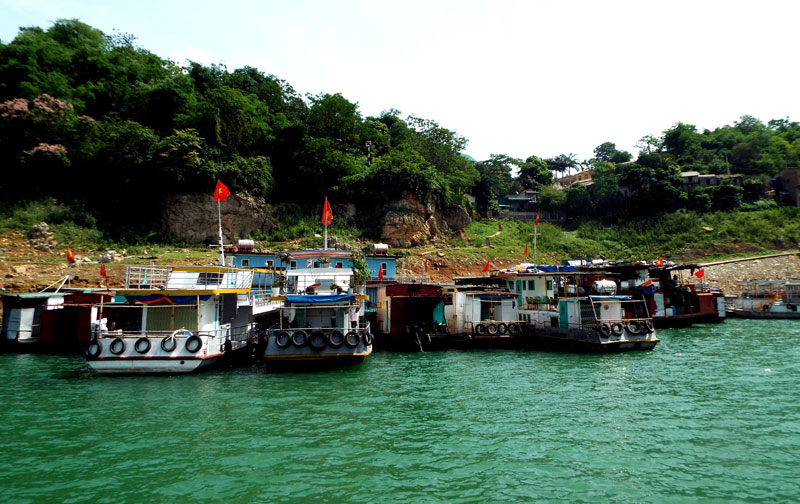
(HBO) - Being the center of the provincial politics, administrations, economy, culture and society, located on the Da River, Hoa Binh City has romantic, scenic nature and becomes the gateway to the Hoa Binh hydroelectric lake. Hoa Binh City possesses great potentials and opportunities to develop tourism models, create stable changes for economy and society. This city has many beautiful spots and famous historical relics, such as: Hoa Binh Hydropower Plant, Historical Site of the Socialist Youth Workers School - where Uncle Ho visited before, Hoa Binh prison, Tien Phi Cave, Ecotourism Area of Co mountain, Giang Waterfall, Ngoi Temple, Tam Mai Temple, Iron Wood in Dan Chu commune, etc.
In particular,
the city has Da River which has become into legend; the very large reservoir of
the Hydroelectric Lake is a fascinating destination for near and far tourists.
Thai Thinh commune, the first place on the way to Hoa Binh Lake, has charming
scenery landscapes. The hamlets still preserves featured traditional culture.
Tourism activities have contributed significantly to transforming the economic
structures of the city. In 2017, the total number of visitors to Hoa Binh City
reached 615,000 people, including 69,000 international tourists and 546,000
national visitors, the total revenue gained 145 billion dongs, the income from
tourism activities reached 261 billion dongs.

A view
of Tru village, Thai Thinh commune, Hoa Binh City.
The Vice Head of
Department of Culture and Sports of Hoa Binh City, Phi Thi Yen informed: Based
on the plan of National Tourism Area of Hoa Binh Lake approved by the Prime
Minister and oriented by the province, the city already built a Project of
developing tourism in Hoa Binh City in the period of 2015- 2020, with a vision
to 2030. Tourism development has become the important economic industry, in
which focuses on investing in various resources, exploiting effectively all the
potentials, strengths, and also focuses on developing tourism products,
especially the reservoir of Hoa Binh Lake. For tourism resort, building the
tourism areas is being implemented associated with entertainment services
following the planning of National Tourism Area of Hoa Binh Lake.
About cultural
tourism, it is necessary to build connecting tourism routes among tourist destinations
of culture and spirit, such as: the historical relics of Hoa Binh Prison,
Historical Site of the Socialist Youth Workers School - where Uncle Ho visited,
Thinh Lang Temple relic, Ngoi Temple, Ba Co Tien Temple, Thang Cave, Museum of
Muong ethnic culture space, etc. The restoration and conservation of
traditional festivals have been done to become tourist destinations with
typical features, such as: Festival of Ngoi Temple, gownsman festival of Dao
ethnic people in Thong Nhat commune.
About community-
based tourism, the selected hamlets will be the ones which still preserve the
typical ethnic cultural values, such as Tru village in Thai Thinh commune, Dong
Chua village in Thong Nhat commune in order to develop the community tourism,
visit traditional handicrafts, understand the local lifestyles and production.
Along with that, the city is implementing the plan of developing sport tourism
such as cycles, motorcycles, terrain cars, golf courses; as well as developing
entertainment models associated with construction investment in shopping
centers, tourist night markets, walking streets of tourism culture, yachting on
the lake reservoir; investing in infrastructure, developing the tourism models
of conferences, seminars, exhibitions, in combination with local food culture.
With an increasingly vibrant and widespread emulation movement aimed at building cultured residential areas and cultured families, Yen Thuy District has been making steady progress toward improving both the material and spiritual well-being of its people, while fostering a civilized, prosperous, beautiful, and progressive community.
Once lacking recreational spaces and community facilities, Residential Group 2 in Quynh Lam Ward (Hoa Binh City) has recently received attention for the construction of a new, spacious, and fully equipped cultural house. The project followed the model of state support combined with public contributions in both labor and funding.
The "All people unite to build cultural life" movement, which has been effectively integrated with Kim Boi district’s socio-economic development goals, is fostering a lively spirit of emulation across local residential areas, hamlets, villages, public agencies, and enterprises. In addition, through the initiative, traditional cultural values are being preserved and promoted, while community solidarity and mutual support in poverty reduction and economic development are being strengthened.
A working delegation of the Hoa Binh provincial People’s Committee led by its Permanent Vice Chairman Nguyen Van Toan on June 11 inspected the progress of a project to build the Mo Muong Cultural Heritage Conservation Space linked to tourism services in Hop Phong commune, Cao Phong district.
Born and growing in the heroic land of Muong Dong, Dinh Thi Kieu Dung, a resident in Bo town of Kim Boi district, in her childhood was nurtured by the sweet lullabies of her grandmother and mother. These melodies deeply imprinted on her soul, becoming an inseparable part of her love for her ethnic group's culture. For over 20 years, this love for her hometown has driven Dung to research, collect, and pass down the cultural values of the Muong people to future generations.
In the final days of May, the Ethnic Art Troupe of Hoa Binh Province organized performances to serve the people in remote, mountainous, and particularly disadvantaged areas within the province. These were not just ordinary artistic shows, but they were the meaningful journeys aimed at spreading cultural values, enhancing the spiritual life of the people and contributing to the preservation of ethnic minority cultural identities.



